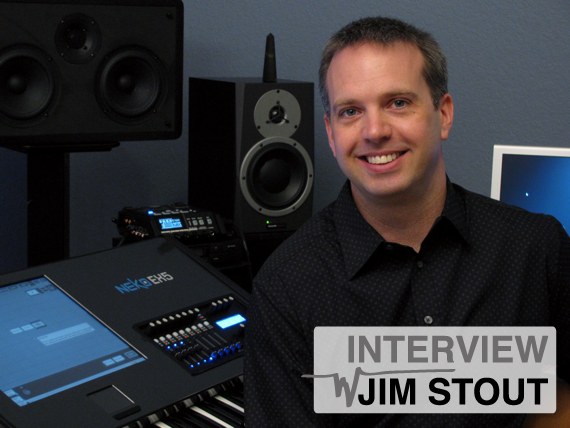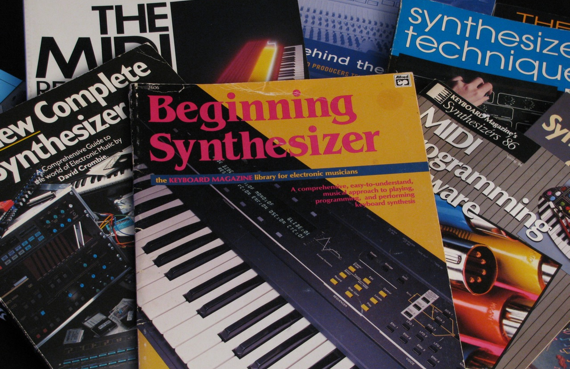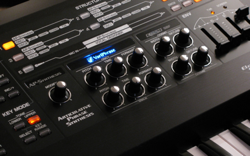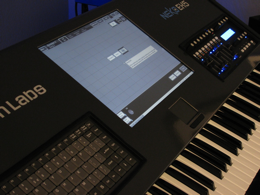
Following with the Jim Stout Special, here is a nice interview I had with him, talking about general aspects of his career and his thoughts on different aspects of sound design. Check:
Designing Sound: Jim, tell us hen you decided to make your career in sound… How do you get started with this?
Jim Stout: I guess you’d have to say it wasn’t a “conscious” decision. I’ve had a fascination with synthesizers from an early age, and I always liked the idea of coming up with sounds no one had ever heard before. From the music world I always liked the strangest ambient textures, and especially the atmospheric sounds of people like Jean-Michel Jerre. As far as making the jump from the music industry to the sound design world goes, I feel like they go hand in hand. It was a very natural evolution for me.
DS: Did you have a mentor early in your career? What was your best source of learning when you were starting out?
JS: No, not really. My mother taught me a lot about music and my father taught me a lot about computers. The rest of my education was just me reading every book I could get my hands on and a lot of trial and error. There wasn’t a whole lot of people doing electronic music, or anything remotely connected to it, where I grew up. I’m pretty sure I was the only middle schooler with a Beginning Synthesizer book. And, my obsession with research was way before the internet so I guess you could say I’m mostly self-taught.

DS: How being a video producer helps you on your career as sound and music producer?
JS: It’s definitely helped me build better sound libraries and assets. Because I can rarely ever find a sound that I like, or one that works with what I’m doing, I generally end up just making my own. And, it’s helped me have a better understanding of, and appreciation for, how sound and video work together to achieve an overall mood or effect.
DS: You’ve created lots of sound effects for industry recognized companies. How do you get involved there? Why do you decided to sell our sound effects?
JS: I was at the 2003 AES show in New York doing some demonstrations with the Roland V-Synth, making wild crazy effects with it. A gentleman walked up to me wearing a Sound Ideas shirt and asked me what I was doing. I said, “These are just some sounds I made with this keyboard.” He handed me his business card and said, “get in touch with me, I have a project that you’d be perfect for.” That guy ended up being the president of Sound Ideas, Brian Nimens. And, I ended up doing a handful of libraries for them. That’s pretty much how I got my foot in the door. As far as why I decided to sell my sound effects, well, it’s not like I was giving away Col. Sander’s secret recipe (laughing). I mean, I don’t really have some great philosophical ideal about “selling one’s creations.” I was just a guy trying to make ends meet like everybody else.

DS: And what about your relationship with music. How do you approach your sound design work there?
JS: In all honesty, I don’t really think I approach them any differently than I used to. The only real change is that the tools have gotten so much more powerful I can pretty much do anything I want. There has always been a fine line between music and sound design for me. When I think back to my EPS [Ensoniq Sampler] days, I can remember rolling brushes around in bathtubs to get whooshing effects, and banging on pots and pans to get metallic drum sounds.
DS: What is your main source of inspiration? When and where do you feel more creative?
JS: I have my best moments when I’m not thinking about it too much or trying to over analyze. My inspiration is everywhere, it’s everything. I carry a portable recorder, literally, everywhere I go. It’s a lifestyle. I never can be sure when or where I’ll hear a sound that will trigger a major creative flux, 90% of the time it’s when I’m thinking about something totally unconnected.
DS: What do you do when you’re creating something and it’s not working?
JS: The only thing I can do is turn everything off. I don’t even bother saving anything I was working on. I walk away for a while, go see my family, or go ride my motorcycle, and try to get as far away from it as possible. After that, when I go back to it I can usually knock it out in ten minutes. Distracting myself clears my head and allows me to start over with a clean slate.
DS: You’ve also worked for Roland, programming sounds there. I think you’ve to create sounds in a very creative-flexible way, so anyone who purchase the synth have different ways to change the sound how they like… Is there something special to create sounds for a commercial synth?
JS: Yes, absolutely. You have to be able to give a listener instant gratification from a sound so when they hear it they immediately think, “Wow, I love that, I want to hear more.” The preset patches are often times what makes a synth sell, regardless of feature set, or functionality- if the preset patches stink, it won’t sell. No one buys a synth because it has 500 sequencing tracks, they buy it because it sounds good.

DS: Can you tell us about your sound design philosophy and/or approach to both organic and synthesized stuff?
JS: I combine both worlds in my work flow. I don’t really separate one from the other. I regularly use organic recordings as the base for a huge amount of my sounds. That’s why I really like the V-Synth and Alchemy, because those give you so much real time control over sampled waveforms.
DS: If you have to choose only three tools (both software and hardware)… What would be your choices?
JS: The V-Synth, the Neko EX5 and Logic.
DS: Someone you admire?
JS: On the sound design front, Ann Scibelli. She is an extremely talented sound designer. On the music front, Alan Wilder.

DS: What do you think about projects such as Tim Prebble’s HISS and a ROAR and Chuck Russom FX and this new way to distribute sound effects around the web? Would be possible to see a Jim Stuff collection?
JS: I think it’s the future, it’s an obvious next step for sound effect delivery. Yes, you will be seeing something similar very soon…
DS: What’s coming next for Jim Stout?
JS: My fourth title with Hollywood Edge, Mechanical Morph, which will be featuring Josh Kay and Richard Devine. And, I’ve got a few more libraries that are slated to begin production very soon. Also, I’m in the process of working on a new ambient/down temp album, and keep an eye out for a download service…
hi jim,
which handheld do you carry around? do you have more than one favorite?
Great interview. You are my inspiration in so many ways! Keep up the fantastic work!
Thanks Jim for sharing your experiences..it helps in learning..;-)..Best Regards